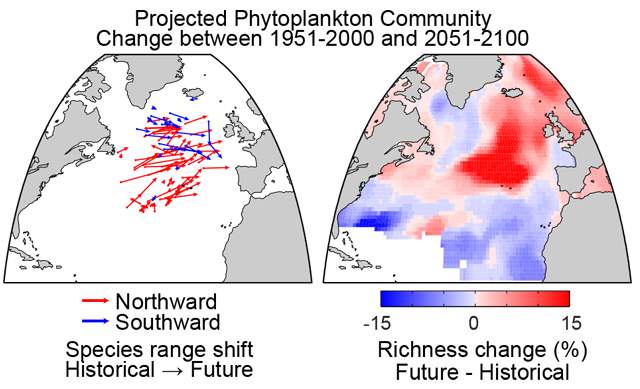February 22nd, 2016
Key Findings
- 74% of phytoplankton taxa shift poleward, with a median rate of 12.9 km dec-1
- 90% of phytoplankton taxa shift eastwards, with a median rate of 42.7 km dec-1
- The poleward shift is faster than previously reported for marine taxa
- The predominance of longitudinal shifts is driven by regional, rather than strictly poleward, redistribution of ocean habitats
- A century of climate change significantly shuffles community composition by a basin-wide median value of 16%, compared with seasonal variations of 46%
- The projected warming in the North Atlantic is often secondary to dynamic changes in mixed layer depth, light, and macronutrients in driving biogeographic shifts
Andrew D. Barton, Andrew J. Irwin, Zoe V. Finkel, Charles A. Stock. Proceedings of the National Academy of Sciences. DOI:10.1073/pnas.1519080113
Summary
This study estimates the impact of projected anthropogenic climate change over the next century on marine phytoplankton communities, and increases our understanding of the environmental drivers of ecological change. The change in biogeography for North Atlantic phytoplankton taxa in response to anthropogenic climate change is quantified, and the primary physical drivers of the projected changes are diagnosed. These findings indicate that over the course of the next century, climate change may significantly modify phytoplankton assemblages throughout the North Atlantic, and may shift individual species ranges considerably, on a magnitude of the exclusive economic zones for the marine territory of many countries.
The study is the first of its kind to examine the climate responses of a large number of phytoplankton species to a broad range of environmental drivers. The authors integrated statistical modeling tools and climate model output, leveraging extensive observations from the North Atlantic region.
Employing the “bioclimate envelope” approach, the authors quantified the realized ecological niche for each species from historical observations, and used this species distribution model (SDM) to map and compare species biogeographies in modeled historical (1951-2000) and projected future (2051-2100) ocean conditions. SDMs were constructed by pairing a half-century of Continuous Plankton Recorder (CPR) species observations with co-located climatologies for 7 observed environmental predictor variables generally found to impact phytoplankton physiology and abundance.
North Atlantic phytoplankton communities support extensive economically important fisheries. As such, their variability and response to climate change are important to understand and assess. This study may help inform climate mitigation and adaptation choices.



